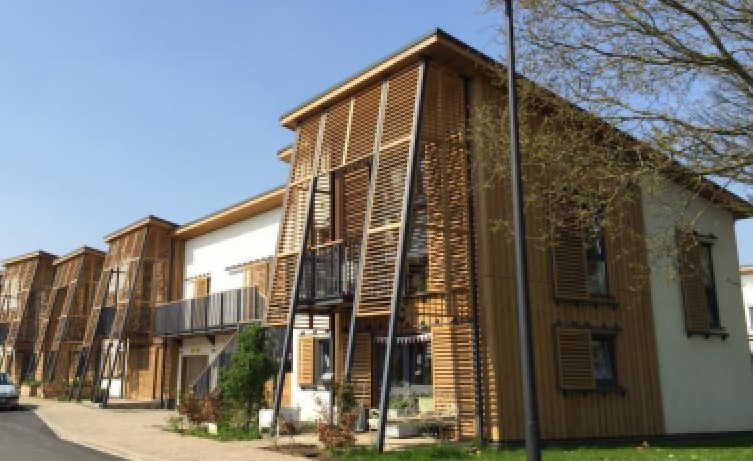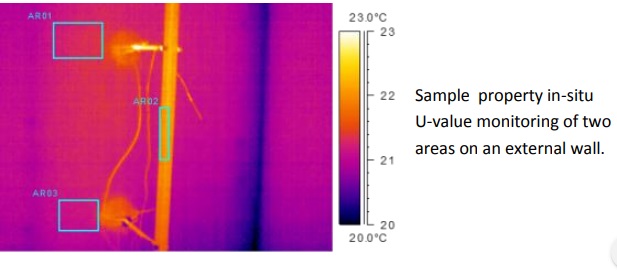Hanham Hall homes performance evaluation

|
Contents |
[edit] Introduction
Hanham Hall is a development of 185 new homes located in South Gloucestershire. All new homes were constructed by Barratt Homes to comply with the Zero Carbon Homes definition. BSRIA was employed to assess the performance of the properties in-use for energy and water consumption, construction quality, indoor environment and to collect the occupants’ opinions on their new homes.
[edit] Process
[edit] Design and standards review
Construction of the homes started on site in 2012 and was completed in early 2016. The design details and energy strategy were reviewed at an early stage. BSRIA reviewed the design brief and SAP predictions, which were used for comparison to monitored data.
[edit] Handover information and home-use manuals
BSRIA collected and reviewed all information handed by the developer to the new home occupants. In addition, researchers participated in new home tours provided to residents by the developer’s team.
[edit] Occupants' satisfaction surveys
Information on site demographics, levels of occupancy in the different properties, and occupants’ levels of satisfaction with their new homes was collected through occupant surveys developed by BSRIA.
[edit] Monitoring energy, water and indoor conditions
Post-occupancy energy and water consumption of all properties was monitored for three years by BSRIA researchers, using wireless sensors which recorded data at five-minute intervals.
A sample of ten properties was reviewed in detail including energy-use patterns, performance of installed services and indoor conditions (IAQ and thermal comfort). In addition, BSRIA performed post-occupancy airtightness tests, thermographic imaging and in-situ U-value measurements to assess the quality of the fabric in the homes.
[edit] Results
[edit] Occupant Satisfaction
Responses indicated that the majority of residents were very satisfied with the performance of their properties. Overall, the respondents reported that their heating, electricity and water bills were much lower compared to bills in their previous homes.
[edit] Energy and water performance
The Hanham Hall houses consumed on average 5500 kWh of gas per year, indicating a high level of energy efficiency. Average regulated and unregulated electricity consumed across the site was less than predicted by SAP models.
Occupants consumed less than 80 litres of water per person per day, meeting the Code for Sustainable Homes* Level 6 target for water consumption.
(* Following the technical housing standards review, the government withdrew the code for sustainable homes, in 2015. Elements of it are still used for the evaluation of sustainable homes.)
[edit] Indoor conditions
CO2 levels monitored in a sample of ten properties indicated good ventilation rates for all the different design typologies.
Thermal conditions within the sample properties showed comfortable temperatures maintained throughout the year with no overheating.
[edit] Installed services
MVHR units installed in the properties consumed similar levels of electricity to that predicted, with no indication of any operational issues.
PV panels generated similar amounts of electricity to that predicted, which accounted for almost 25% of annual electricity demand in monitored properties.
[edit] Notes and considerations
- The handover process review indicated the need for improvement. Findings identified a complex presentation of content, and a lack of information relating to the long-term maintenance and operation of the properties.
- Some occupants found operating their heating systems challenging, reporting that controls could be simpler and easier to understand.
- Even though gas consumption of the properties was low, it was 40-60% higher than SAP predictions. Although used for comparison purposes in the study, SAP predictions do not accurately predict in-use energy consumption.
- Airtightness tests conducted on four properties three years after construction, indicated a deterioration from the initial tests which were less than 1.5 m3/m2h @ 50 Pa. All results were less than 3m3/m2h @ 50 Pa.
The research programme provided Barratt Homes with a unique insight into the performance and quality of its new home designs.
[edit] About this article
This article was written by BSRIA in conjunction with Barratt Homes. It was previously published on the BSRIA website and can be accessed HERE under 'homes performance evaluation'.
More articles by BSRIA on Designing Buildings Wiki can be found HERE.
[edit] Related articles on Designing Buildings Wiki
- Approved documents.
- Building Regulations.
- BREEAM.
- Consequential improvements.
- Dwelling Emission Rates.
- Earthship.
- Eco town.
- Energy certificates.
- Green deal.
- Home Quality Mark.
- Leadership in Energy and Environmental Design.
- Lifetime homes.
- Lifetime neighbourhoods.
- Nationally described space standard.
- NHBC technical standards.
- Passivhaus.
- Roof insulation.
- Ska rating.
- Sustainability.
- Sustainable Urban Drainage Systems.
- U-values.
- Zero carbon homes.
--BSRIA
Featured articles and news
RTPI leader to become new CIOB Chief Executive Officer
Dr Victoria Hills MRTPI, FICE to take over after Caroline Gumble’s departure.
Social and affordable housing, a long term plan for delivery
The “Delivering a Decade of Renewal for Social and Affordable Housing” strategy sets out future path.
A change to adoptive architecture
Effects of global weather warming on architectural detailing, material choice and human interaction.
The proposed publicly owned and backed subsidiary of Homes England, to facilitate new homes.
How big is the problem and what can we do to mitigate the effects?
Overheating guidance and tools for building designers
A number of cool guides to help with the heat.
The UK's Modern Industrial Strategy: A 10 year plan
Previous consultation criticism, current key elements and general support with some persisting reservations.
Building Safety Regulator reforms
New roles, new staff and a new fast track service pave the way for a single construction regulator.
Architectural Technologist CPDs and Communications
CIAT CPD… and how you can do it!
Cooling centres and cool spaces
Managing extreme heat in cities by directing the public to places for heat stress relief and water sources.
Winter gardens: A brief history and warm variations
Extending the season with glass in different forms and terms.
Restoring Great Yarmouth's Winter Gardens
Transforming one of the least sustainable constructions imaginable.
Construction Skills Mission Board launch sector drive
Newly formed government and industry collaboration set strategy for recruiting an additional 100,000 construction workers a year.
New Architects Code comes into effect in September 2025
ARB Architects Code of Conduct and Practice available with ongoing consultation regarding guidance.
Welsh Skills Body (Medr) launches ambitious plan
The new skills body brings together funding and regulation of tertiary education and research for the devolved nation.
Paul Gandy FCIOB announced as next CIOB President
Former Tilbury Douglas CEO takes helm.
UK Infrastructure: A 10 Year Strategy. In brief with reactions
With the National Infrastructure and Service Transformation Authority (NISTA).
























